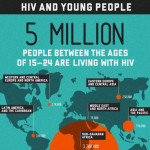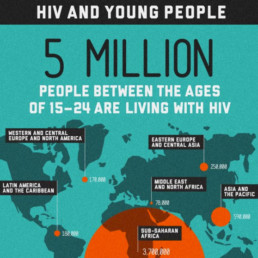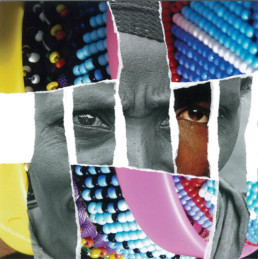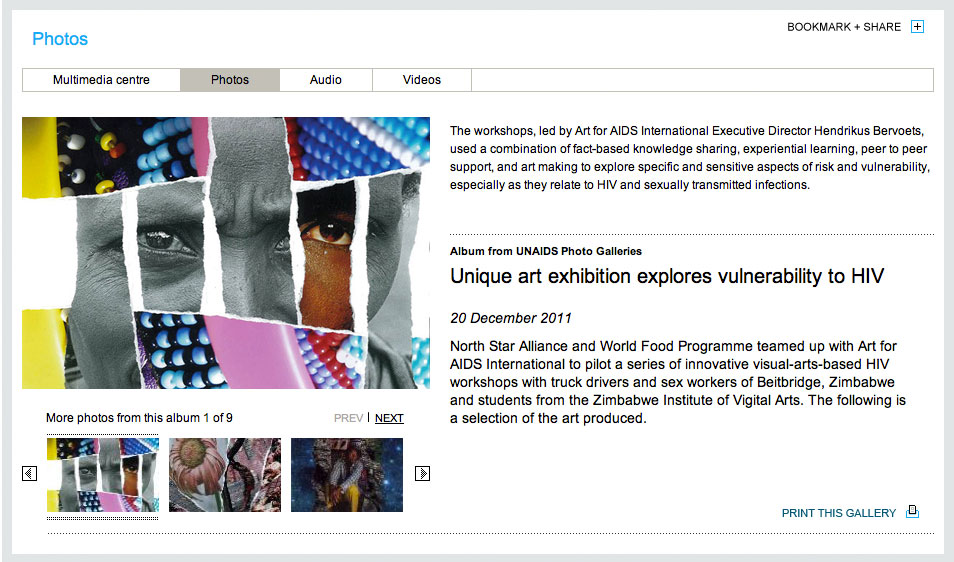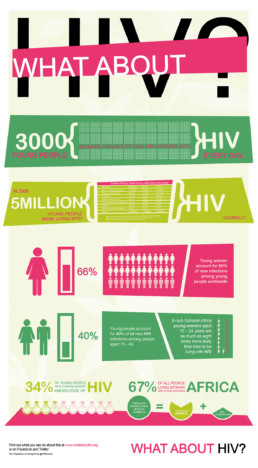HIV and Young People [Infographic]
In 2011, the Joint United Nations Programme on HIV/AIDS (UNAIDS) challenged young people from around the world to collaborate and crowdsource the next global HIV strategy. This past April, we were excited to share that strategy with all of you along with our commitment support tens of thousands of young people in promoting this campaign. Today, to build on that commitment, we wanted to share with you the latest CrowdOutAIDS infographic and encourage all of you in turn to share this important information with others.
Globally, its estimated that five million young people (15-24 years of age) are living with HIV. About 3000 young people are newly infected with HIV each day. According to recent surveys in low- and middle-income countries, only 24% of young women and 36% of young men responded correctly when asked questions on HIV prevention and transmission.
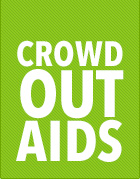 For more details on CrowdOutAIDS visit http://www.crowdoutaids.org/.
For more details on CrowdOutAIDS visit http://www.crowdoutaids.org/.
To read other Art for AIDS International posts related to UNAIDS visit: http://www.artforaidsinternational.org/tag/unaids/
CrowdOutAIDS: A new youth-driven, youth-focused HIV strategy
 In 2011, the Joint United Nations Programme on HIV/AIDS (UNAIDS) challenged young people from around the world to collaborate and crowdsource the next global HIV strategy. Today, after five months of collaborative efforts, youth leaders from around the world met in Abuju Nigeria to present CrowdOutAIDS to UNAIDS Executive Director Michel Sidibé; a new strategy produced by more than 5000 young people from 79 countries that will guide the UNAIDS Secretariat’s work on HIV and young people through 2015.
In 2011, the Joint United Nations Programme on HIV/AIDS (UNAIDS) challenged young people from around the world to collaborate and crowdsource the next global HIV strategy. Today, after five months of collaborative efforts, youth leaders from around the world met in Abuju Nigeria to present CrowdOutAIDS to UNAIDS Executive Director Michel Sidibé; a new strategy produced by more than 5000 young people from 79 countries that will guide the UNAIDS Secretariat’s work on HIV and young people through 2015.
Leveraging social media and new crowdsourcing technology enabled young people to shape the future of the global response to AIDS, a first in United Nations history. “It brought decision-making to the grassroots, to the skilled and unskilled, learned and unlearned, rich and poor, to contribute to an issue that affects all our lives: HIV," said Nigerian activist Gabriel Adeyemo.
“I am so impressed by the dedication, energy and enthusiasm that young people have shown through the CrowdOutAIDS initiative,” said Mr Sidibé. “The recommendations they have presented to UNAIDS will help us mobilize a new generation of young leaders and we will work together to stop new HIV infections and AIDS-related deaths.”
Globally, its estimated that five million young people (15-24 years of age) are living with HIV. About 3000 young people are newly infected with HIV each day. According to recent surveys in low- and middle-income countries, only 24% of young women and 36% of young men responded correctly when asked questions on HIV prevention and transmission.
Through CrowdOutAIDS, young people proposed six key recommendations for the UNAIDS Secretariat:
- Strengthen young people’s skills for effective leadership at all levels of the AIDS response;
- Ensure the full participation of youth in the AIDS response at country, regional, and global levels;
- Improve young people’s access to HIV-related information;
- Diversify and strengthen strategic networks between the UNAIDS Secretariat, youth networks, and other key players;
- Increase the UNAIDS Secretariat’s outreach to both formal and informal networks of young people; and,
- Increase young people’s access to financial support.
“We have worked together, using the simplest tools—each one of us in their own corner of the world—to create spaces of exchange and draft this important document in real-time, public online sessions,” said Zahra Benyahia, a CrowdOutAIDS drafting committee member. “This is not the end. It’s the first step toward revolutionary youth leadership in the AIDS response.”
For more details on CrowdOutAIDS visit http://www.crowdoutaids.org/ or check out UNAIDS' Press Release
Photo Source: CrowdOutAIDS
UNAIDS features collaborative Art for AIDS project
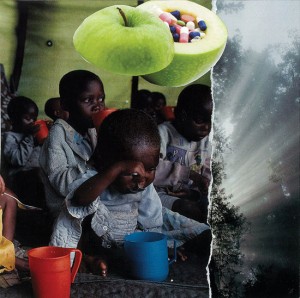 In September we told you about a collaborative pilot project between North Star Alliance, the World Food Programme, and of course, Art for AIDS, focused on extending our arts-based workshops model to truck drivers, sex workers, and students located in both Beit Bridge and Harare, Zimbabwe. While this was by no means our first student-workshop (check out our full list of workshop locations), it was the first time we had hosted workshops with truck drivers and sex workers, two populations that are particularly vulnerable to, and disproportionately affected by HIV, STIs, and other communicable diseases.
In September we told you about a collaborative pilot project between North Star Alliance, the World Food Programme, and of course, Art for AIDS, focused on extending our arts-based workshops model to truck drivers, sex workers, and students located in both Beit Bridge and Harare, Zimbabwe. While this was by no means our first student-workshop (check out our full list of workshop locations), it was the first time we had hosted workshops with truck drivers and sex workers, two populations that are particularly vulnerable to, and disproportionately affected by HIV, STIs, and other communicable diseases.
Following the workshops, all of us at Art for AIDS were excited by both the powerful artwork each participant produced, and by the high quality discussions about HIV that came out of the workshops. Over the past few months, we've been even more excited to watch public enthusiasm for this project grow.
Thanks to tremendous support from both North Star Alliance and the World Food Programme this project was featured with a large exhibition in September at the International Fund for Agricultural Development's (IFAD) Global Knowledge Share Fair, and at the World Food Programme's Head Quarters over World AIDS Day. The project has also been featured at exhibits in London and Toronto, Canada, and in Utrecht, the Netherlands.
This week, UNAIDS (the Joint United Nations Programme on HIV/AIDS) highlighted this initiative as well by posting a special photo gallery showcasing some of the works of art produced along with an explanation of the project. To view this gallery, please click the image below:
We would like to thank UNAIDS for highlighting this feature, and both North Star Alliance and the World Food Programme for the tremendous work they do, and the vision and support they've brought to this initiative.

About North Star Alliance
North Star Alliance is a not-for-profit public private partnership that provides healthcare and information to truck drivers, sex workers, and border communities through a network of roadside health clinics across Africa.
You can learn more about North Star by visiting them online or by joining them on Facebook.
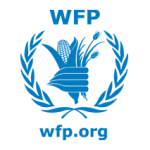
About The World Food Programme
WFP is the food aid arm of the United Nations system, and the largest humanitarian agency fighting hunger.
You can learn more about WFP by visiting them online or by joining them on Facebook.
What about HIV? [INFOGRAPHIC]

Thirty years into the response to HIV, an estimated 3000 young people are newly infected with HIV everyday. Many young people living with HIV still do not have access to treatment and only 34% of all young people have correct and comprehensive knowledge about HIV and how to protect themselves. That's why more than 150 young HIV activists from across the world gathered for a three-day summit in Bamako, Mali, last week to rally a youth-led response to HIV in lead up to the United Nations General Assembly High Level Meeting on AIDS (taking place in New York from 8 to 10 June 2011). Read more
2010 UNAIDS Report and the State of the HIV/AIDS Pandemic

Parts of this post originally appeared on Notes From the Field, a blog written by Art for AIDS International board member JP Bervoets.
This past week UNAIDS released the 2010 Report on the Global AIDS Epidemic. In it, UNAIDS highlights a number of key successes that seem to suggest that the HIV/AIDS pandemic has passed peak infection levels. One statistic in particular has been drawing considerable media attention: New infections have dropped by 20% globally.Read more
Twenty-two of the most affected countries in sub-Saharan Africa have reduced new HIV infections by more than 25%
 Over the last 25 or so years, many individuals working on the front lines in the fight against HIV and AIDS have had to become accustomed to accepting and celebrating the little victories. Barring a few notable exceptions where a given community or country has been able to legitimately curb and reduce the spread of HIV, many of us have excitedly relished in those moments when on an individual level, or in an individual case, a level of understanding, or the standard of living, of someone infected or affected by HIV/AIDS has improved. Recognizing that, in aggregate, these moments are a significant variable in an eventual end to the HIV/AIDS pandemic, has, however, been at times trying, especially in the face of the overwhelming AIDS statistics released annually. This is why many were ecstatic this week to learn that 22 of the worst affected countries in sub-Saharan Africa have reduced new HIV infections by over 25%.
Over the last 25 or so years, many individuals working on the front lines in the fight against HIV and AIDS have had to become accustomed to accepting and celebrating the little victories. Barring a few notable exceptions where a given community or country has been able to legitimately curb and reduce the spread of HIV, many of us have excitedly relished in those moments when on an individual level, or in an individual case, a level of understanding, or the standard of living, of someone infected or affected by HIV/AIDS has improved. Recognizing that, in aggregate, these moments are a significant variable in an eventual end to the HIV/AIDS pandemic, has, however, been at times trying, especially in the face of the overwhelming AIDS statistics released annually. This is why many were ecstatic this week to learn that 22 of the worst affected countries in sub-Saharan Africa have reduced new HIV infections by over 25%.
This new data was made available in a UNAIDS press release issued September 17th, just ahead of the upcoming United Nations Summit on the Millennium Development Goals. In it, UNAIDS Executive Secretary Michel Sidibe states that "for the first time change is happening at the heart of the epidemic. In places where HIV was stealing away dreams, we now have hope".
Read more
